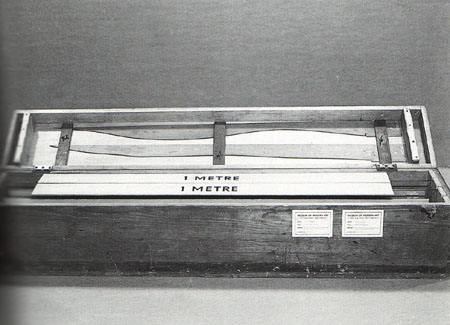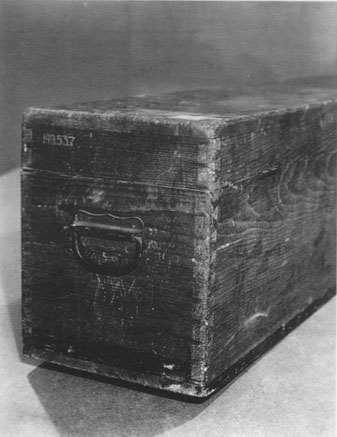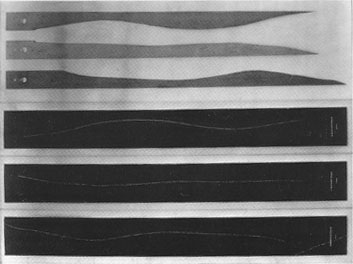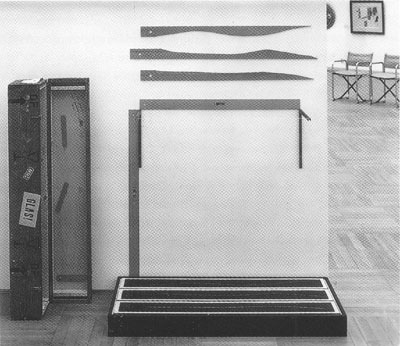
Three Standard Stoppages
or
Tinned Chance: Trois stoppages etalon
 |
| Original version, 1913-14 |
|
Original Version:
1913-14, Paris |
This Readymade illustrates Duchamp's fascination with the concept of chance and his interest in mathematics. This complex construction incorporates a number of complicated elements, all inside a wooden box:
1) Three pieces of thread, each one-meter long, glued on Prussian blue canvas cut into three strips (each 120 x 13.3 cm). These canvas strips are glued to three glass panels (each 125.4 x 18.3 cm).
2) Three wood slats, shaped along one side to match the curved paths taken by the threads (119.4 x 6.1 cm; 109.1 x 6.2 cm; 109.8 x 6.3 cm)
3) A black leather label with "3 STOPPAGES ETALON/ 1913-14" printed on it in gold lettering is attached on one end of each canvas strip.
 |
| Original version wooden box, 1913-14 |
The following notations are printed on the back of each canvas strip, where you can see them through the glass that the canvas is mounted on: "Un metre de fil droit, horizontal, tombe d'un metre de haut. (3 Stoppages etalon; appartenant a Marcel Duchamp. / 1913-14)." This translates to the following in English: "A straight horizontal thread one meter in length falls from a / height of one meter. (3 Standard Stoppages; belonging to Marcel Duchamp. / 1913-14)." In other words, Duchamp included a detailed description of the making process of the Readymade within the artwork itself.
In 1953, when it was shown with Katherine Dreier Bequest at the Museum of Modern Art in New York, Duchamp added two more elements to the already intricate 3 Standard Stoppages: (1) two wooden meter sticks marked "1 METRE" and (2) a label by Alfred H. Barr, Jr. reading "In this exhibition [1953] three stretched threads and two meter sticks, one vertical and one horizontal, have been added at the suggestion of the artist to clarify his procedure." This addition further illustrates Duchamp's attempt to show the making process (whether by chance or not). This apparent clarity initially does not feel very Duchampian. But at the same time, it is a very strategic process, like chess, and encapsulates the Readymade idea of taking the concrete and applying non-concrete ideas to it. The 1963 replica photograph below clearly illustrates this. The meter sticks literally measure out the height from which the threads were dropped onto the canvas and the results of the experiment sit on the ground below as if they have just fallen.
 |
| Original version, 1913-14 3 wood slats, 3 canvas strips with string |
The following is an account of the making process of Three Standard Stoppages:
Duchamp dropped three threads, each a meter long, on to the same number of Prussian blue cloths/canvas. Then they were stuck to the surfaces without any adjustments to the curves that chance dictated they fell into. He then cut up the cloth and stuck it to glass plates, finally encasing them in a wooden box. A few wooden "rulers," which were cut following the same curves, were added (Ramirez 35).
The title of this piece is also, in part, the result of chance. Schwarz explains, "[Duchamp] decided upon the title when, during a stroll, he spotted the sign Stoppages ("invisible meaning") over a shop on the rue Claude Bernard, in Paris. From the tailor's use of sewing to his own experiments with the material seemed a natural step" (595).
The status of this piece as a Readymade has been frequently questioned throughout the history of Duchampian discourse. Tomkins highlights this fact, noting Three Standard Stoppages as one of a number of "debatable cases" (159). For example, while Schwarz calls a large number of Duchamp's works Readymades, he does not term Standard Stoppages as such; rather, he refers to it as an "Assemblage, founded on chance" (594). However, Ramirez includes this work in the small group of pieces he acknowledges as Readymade (35).
This piece contains a number of close connections with Duchamp's major work The Bride Stripped Bare by her Bachelor's, Even (or Large Glass) that he was working on when he made Three Standard Stoppages. Duchamp used the curved pieces of the Readymade as rulers for guide lines in other art pieces, including part of the bachelor machine in the Large Glass. Interestingly, this connection within his oeuvre questions a central aspect of the Readymade as a concept. As Ramirez points out, in effect Three Standard Stoppages has a definite function that may be fulfilled (at least for the artist himself); this stands as contrary to the basic idea of Readymades as functional objects rendered useless.
Most scholars traditionally argue that the inspiration for the assemblage that is Three Standard Stoppages was a croquet box. However, Ramirez argues that it was inspired by the cases used to store rulers and patterns used in technical drawing. He cites the catalogues of W.F. Stanley and Lietz as iconographic sources in support of this argument (36).
 |
| Replica, 1963 |
2) 1963, Pasadena
Norton Simon Museum, Pasadena, California
3 stoppages (128.8 x 18.2 cm), 3 shaped wood slats (112.5 cm long)
Made by Baldev Duggal, New York, under Duchamp's supervision for his retrospective in Pasadena, CA
Inscribed on wood slat: "pour certifie conforme Marcel Duchamp 1963"